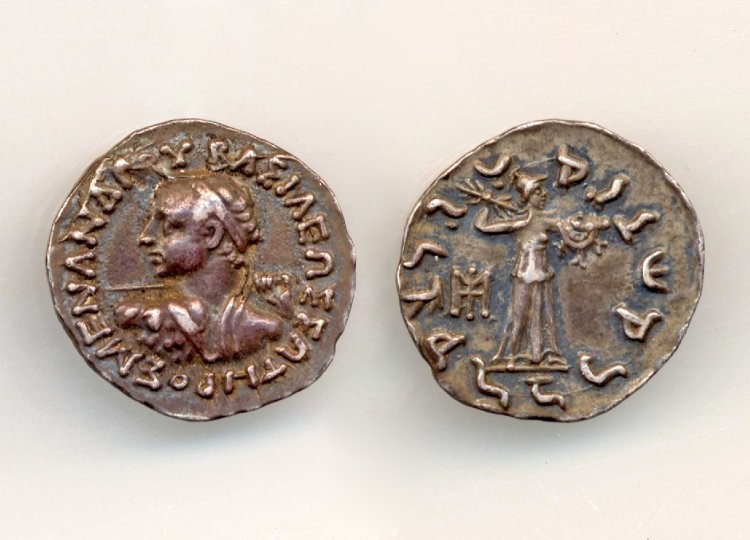January 8, 2017, by Will Leveritt
Berger, Boundaries, Buddhism: looking at a Greek coin
Written by W. G. Leveritt
The way we see things is affected by what we know or what we believe.
John Berger, Ways of Seeing
Sadly, at the start of this year, we lost the great John Berger. He was extremely accomplished in a number of areas – as a poet, novelist, painter – but was probably most famous as an art critic. Speaking personally, it was his celebrated work Ways of Seeing that first brought him to my attention. The series and the book are now pushing 45 years old, and when I first saw them it had been many years since they were new; but they were certainly still fresh.
There are a great many things that Berger wrote or said that resonate strongly with me, when I look at things in my area of interest: ancient Mediterranean art and the history of how its ancient peoples thought about themselves, and their own pasts and futures. But the quote above struck me as especially apposite when I was thinking about a particular ancient coin.
Ancient coins might seem like quite a dry and boring topic; but looking at (or even better, holding) an ancient coin is quite different from looking at (or running the risk of touching) a grand monument of the state. Coins were issued by high-echelons of society, for sure, but they were very definitely passed through unknowable hands lost to history – and they were even looked at and thought about by the people that handled them, even though probably seldom as closely as academics would ideally hope they were.
The coin in the picture, then, is a great example of how we shouldn’t be led astray by what we think we know. It shows a man turning and brandishing a spear, with his back to the camera, as it were. He proudly displays a martial masculinity through broad shoulders and a jabbing weapon, but also respectability and royalty with his slightly balding forehead and kingly diadem. The inscription, in Greek, announces that his is King Menander, saviour. On the back of the coin, the image is of a draped female figure wearing a helmet and holding a distinctive shield; the stretched star-shape is meant to represent a lightning-bolt. All these things mean she must be Athena.
So much, so familiar to Classicists. We have some Greek king and a familiar goddess; a brash statement of the king’s butch dominance, and a rather unsubtle link between him and the divine. Both figures brandish spears, and they both defend the people. They are – literally – two sides of the same coin. But if we left it here, we would miss a great deal. There is more to the coin than just this.
There is a strange marking in the left hand of the coin’s reverse side, and a peculiar inscription. The inscription is not Greek, and it is certainly not Latin. It is Kharoṣṭhī, the ancient script of Gandhara. It reads Maharajasa tratarasa Menadrasa, telling us that this is a coin of King Menandra, the saviour. The mark is the symbol of the mint, showing that it was made in Taxila, a city about twenty miles west of Islamabad in modern day Pakistan.
Menander ruled over an Indo-Greek kingdom, and died in 130BC. Crucially – and unlike almost any other Greek of this time that we know about – he was a convert from the Greek religion (of Athena and Zeus so on) to Buddhism. The Questions of King Menander, a Buddhist text from the first century BC, tells us about this. After a series of philosophical debates with a great sage, Menander is won over by Buddhist beliefs, abandons his monarchic rule, and very successfully follows the teachings:
And afterwards, taking delight in the wisdom of the Elder, he handed over his kingdom to his son, and abandoning the household life for the houseless state, grew great in insight, and himself attained to Arahatship.
(Trans. Rhys Davids, 374.)
To return to the quote with which we began, then, I think we can consider the coin from two perspectives: modern, and ancient.
From a modern perspective, it is very easy when looking at an artefact to end up paying more attention to the elements we know about and anticipate. The ancient cultures of the Mediterranean spread more widely and interacted in more complex ways with other cultures than the popular image of Classics often allows. The coin emphatically announces that traditional divisions between disciplines are artificial and unhelpful. It can be understood entirely neither from a detached Eastern nor a detached Western perspective, and suggests in its case that such categories should be emptied out and reconsidered.
But bigger questions come from thinking about ancient perspectives and ways of seeing; what did the coin’s various – and highly varied – audiences think about it as it passed through their hands?
For more ancient coins, please see our partner blog Mint Imperials.


For the issued it was a statement! For the people who used it was a necessity to survive! And for those wo are looking at it now it is a piece of history!
I’m a bit of a collector myself and the stories of the coin and people of their time can be as fascinating as the coin itself. I admire your ability to research, interpret, and tell the story.